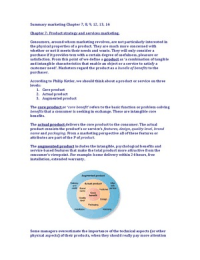Summary marketing Chapter 7, 8, 9, 12, 13, 14
Chapter 7: Product strategy and services marketing.
Consumers, around whom marketing revolves, are not particularly interested in
the physical properties of a product. They are much more concerned with
whether or not it meets their needs and wants. They will only consider a
purchase if it provides tem with a certain degree of usefulness, pleasure or
satisfaction. From this point of we define a product as ‘a combination of tangible
and intangible characteristics that enable an object or a service to satisfy a
customer need’. Marketers regard the product as a bundle of benefits to the
purchaser.
According to Philip Kotler, we should think about a product or service on three
levels:
1. Core product
2. Actual product
3. Augmented product
The core product or ‘core benefit’ refers to the basic function or problem-solving
benefits that a consumer is seeking in exchange. These are intangible core
benefits.
The actual product delivers the core product to the consumer. The actual
product consists the product’s or service’s features, design, quality level, brand
name and packaging. From a marketing perspective all of these features or
attributes are part of the P of product.
The augmented product includes the intangible, psychological benefits and
service-based features that make the total product more attractive from the
consumer’s viewpoint. For example: home delivery within 24 hours, free
installation, extended warranty.
Some managers overestimate the importance of the technical aspects (or other
physical aspects) of their products, when they should really pay more attention
,to the benefits that interest consumers. These benefits may include the user-
friendliness of the purchased product, the quality of the instructions in the user
manual for installing the product or the level of customer service. Often, these
are the product attributes that make a difference in a purchase decision or the
choice between brands.
Depending on the use for which they are intended, products can be classified as
two different types of products:
1. Consumer products
2. Business products.
Consumer products are sold to individuals and their families for their personal
use or consumption. These buyers are known as ultimate consumers or end
users of the product. Televisions, cosmetics and candy are all consumer goods.
On the other hand, business products or industrial goods (such as production
equipment, materials, supplies and software) are sold to organizations –
including, companies, government agencies and non-profit organizations – that
either resell them or use them to make products or to provide a service).
Marketers have classified consumer goods, depending on consumer buying
attitudes and behavior, into four classes:
1. Convenience products
2. Shopping products
3. Specialty products
4. Unsought products
Convenience products are items that the consumer buys frequently,
immediately and with a minimum effort of shopping effort. Because most brands
are fairly similar (such as soap, gasoline and milk), the consumer spends little
time comparing prices and quality. He has a preferred brand, but will accept a
substitute. Convenience products can be further categorized into:
Staples: fast-moving consumer goods (e.g. bread)
Impulse goods: purchased with no pre-planning or careful decision-
making (e.g. adding a packet of chewing gum while standing in line)
Emergency goods: purchased when the consumer urgently needs them
(e.g. an umbrella during a downpour)
Shopping products are items for which the consumer normally compares the
quality, price and style of a number of alternatives, often visiting several stores
before making a purchase decision. They can be homogeneous or heterogeneous.
Specialty goods are items (such as parachutes, Rolex watch) or services (such as
child care) that consumers are willing to make a special effort to acquire. The
purchase is characterized by high involvement and a high degree of brand loyalty
and is usually very expensive.
Unsought products are products and services of which consumers are unaware,
haven’t necessarily though of buying or discover they need in order to solve an
, unexpected problem. Examples are life insurance, encyclopedias and emergency
car-towing services. The category of new unsought products includes items that
haven’t been on the market long and are unknown until advertising and
distribution increase consumer awareness.
Durable consumer goods are products such as cars, MP3 players and
dishwashers, which are used repeatedly over an extended period. They have
relatively high profit margins.
Non-durable consumer goods have a relatively short life cycle. Like clothing
and footwear, they rarely last longer than about three years.
If these ‘consumables’ are consumed or used up fairly quickly, they are known as
fast moving consumer goods.
Services are products that are intangible and provide benefits that meet certain
needs and wants, such as bicycle repairs.
The product mix is the total assortment of products and services that the
company sells, including various product lines, products, products types and
brands.
A product line is a group of closely related items in the organization’s
assortment or product mix.
Products within a product line share some common features or technological
characteristics. The relationships between them can be based on various factors
such as:
Production (made in the same factory)
Distribution (sold in the same store)
Price (falling within a given price range)
Marketing (targeted at the same customer group)
Consumption pattern (satisfying a similar need or used together as
complementary products)
A product type is an individual product or a specific version of a service that
differs from other types of the same product because of certain attributes.
A product type is also referred to as an article or product item, if it can be
designated as a distinct offering within the company’s products or is listed in the
firm’s catalogue or on its website with a specific article number.
In many companies, a different marketing or product manager manages each
product line. However, decisions that affect the assortment as a whole are
usually made at a higher organizational level. When making these strategic
decisions, top management considers four dimensions of the product mix:
The width
The length
The depth
The consistency






